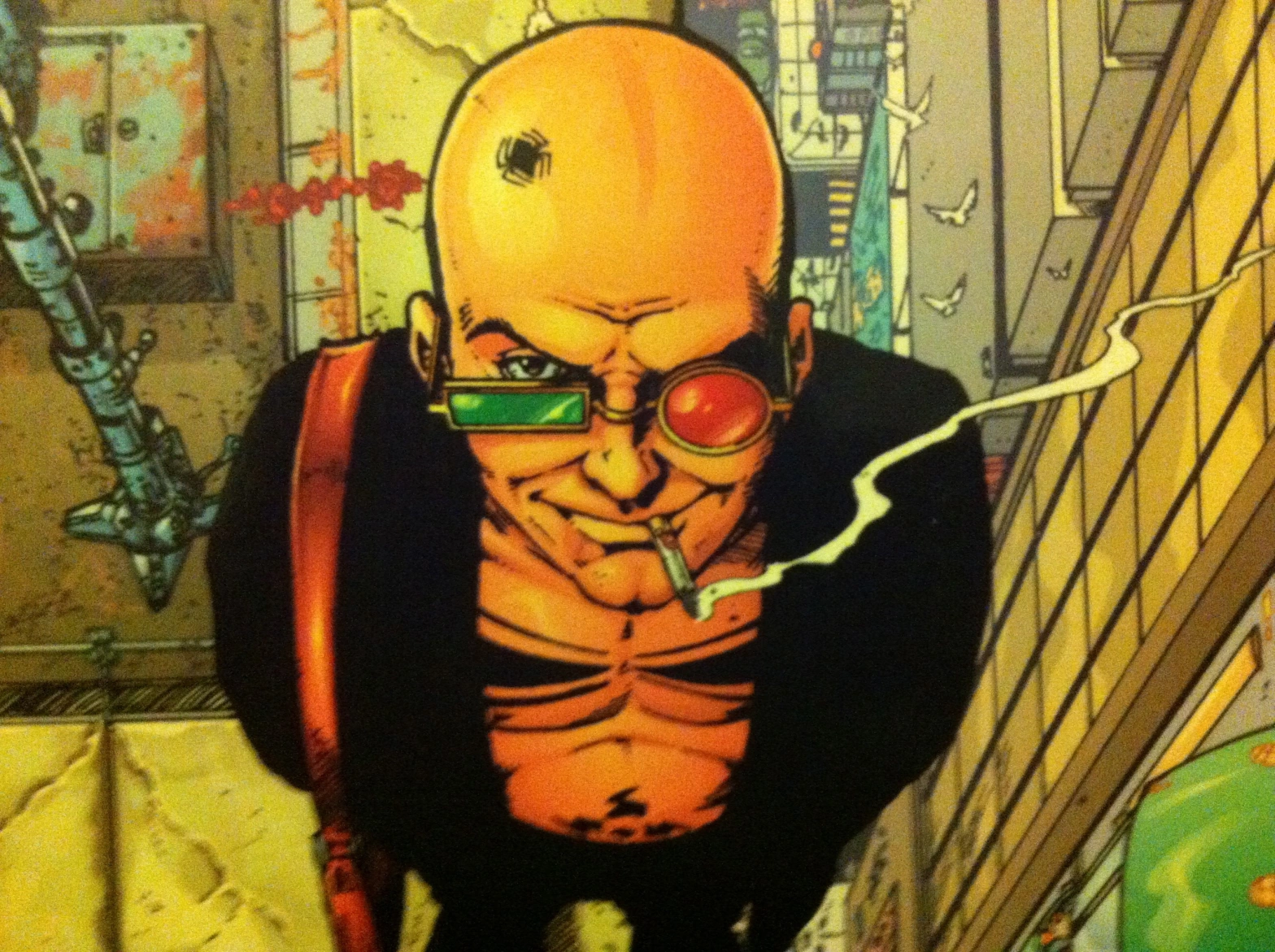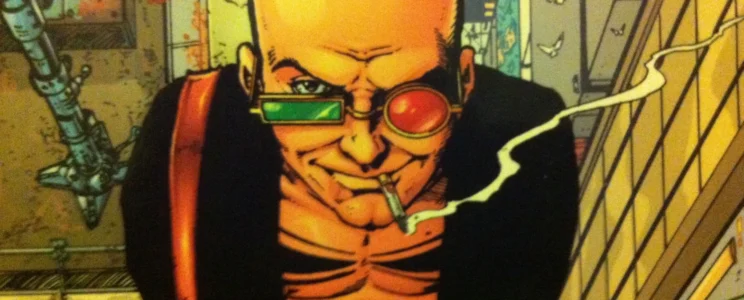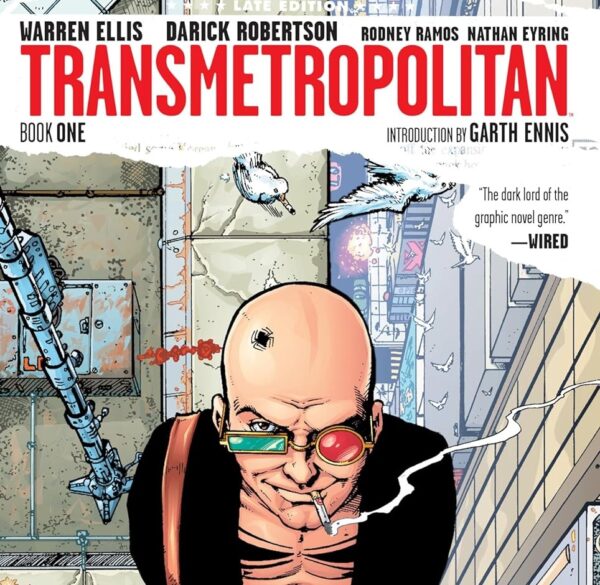Transmetropolitan
Delve into the extraordinary world of Warren Ellis, a maestro of comic storytelling, whose distinctive style ignites the pages of the graphic novel “Transmetropolitan.” Ellis’s narrative prowess and visionary artistry redefine the conventions of the genre, crafting a dystopian masterpiece that captivates readers with its audacious characters, incisive themes, and relentless exploration of humanity’s darkest facets.
Warren Ellis: A Trailblazer in Graphic Fiction
Warren Ellis, an iconic figure in the comic book realm, is renowned for his boundary-pushing narratives and uncompromising vision. With a career spanning decades, Ellis has left an indelible mark on the medium, earning accolades for works such as “Planetary,” “The Authority,” and “Global Frequency.” His distinctive blend of social commentary, razor-sharp wit, and unflinching exploration of human nature distinguishes him as a luminary in the world of graphic storytelling.
Unraveling the Plot
“Transmetropolitan” unfurls against the backdrop of a futuristic metropolis known as the City. The story follows the exploits of Spider Jerusalem, an abrasive and irreverent journalist, as he navigates the urban landscape teeming with corruption, depravity, and technological excess.
The narrative kicks off with Spider, a renowned gonzo journalist who has retreated to the mountains to live in isolation. However, circumstances compel him to return to the City, where he is immediately thrust into the heart of its seedy underbelly. Armed with his unyielding commitment to truth and justice, Spider embarks on a crusade to expose the corruption festering within the corridors of power.

As the series progresses, Spider’s investigations lead him down a labyrinthine path, uncovering conspiracies, scandals, and dark secrets lurking beneath the veneer of civilization. Along the way, he encounters a colorful cast of characters, from rogue politicians to cybernetic freaks, each adding layers of intrigue and complexity to the narrative tapestry.
Key Characters and Their Impact
he vibrant and multifaceted characters of “Transmetropolitan” play a pivotal role in shaping the narrative landscape, infusing the story with depth, nuance, and emotional resonance. From the larger-than-life protagonist to the supporting cast of allies and adversaries, each character leaves an indelible mark on the reader, enriching the tapestry of Warren Ellis’s dystopian masterpiece.
Spider Jerusalem: The Unconventional Protagonist
At the heart of “Transmetropolitan” lies Spider Jerusalem, a maverick journalist whose unorthodox methods and uncompromising ethos make him a force to be reckoned with. Possessing a razor-sharp intellect and a penchant for chaos, Spider embodies the archetype of the antihero, challenging authority and exposing corruption with equal parts cynicism and idealism. His relentless pursuit of truth often leads him into perilous situations, yet his unwavering commitment to justice fuels his crusade against the injustices of the City.
Spider’s impact extends beyond his journalistic endeavors, as his complex character serves as a lens through which readers explore themes of morality, identity, and the nature of power. His abrasive demeanor masks a deep-seated sense of compassion and integrity, making him a compelling and contradictory figure whose actions resonate long after the final page is turned.
Channon Yarrow: The Loyal Confidante
As Spider’s steadfast ally and confidante, Channon Yarrow provides a counterbalance to his volatile nature, grounding the story with her unwavering loyalty and moral compass. A former stripper turned bodyguard, Channon serves as Spider’s voice of reason, offering insights and support as he navigates the treacherous waters of the City. Despite the chaos that surrounds them, Channon remains a steadfast presence in Spider’s life, embodying the resilience and strength of character that define her as a formidable force in her own right.
Channon’s impact on the narrative lies in her ability to humanize Spider, revealing the vulnerability and humanity beneath his gruff exterior. Their dynamic relationship serves as a poignant reminder of the power of connection in a world defined by isolation and alienation, underscoring the importance of camaraderie and solidarity in the face of adversity.
The Smiler: A Machiavellian Adversary
In stark contrast to Spider’s crusade for justice stands The Smiler, a cunning and manipulative politician whose Machiavellian machinations pose a formidable threat to Spider’s efforts. With his charming facade and ruthless ambition, The Smiler represents the corrupting influence of power, using deception and manipulation to maintain his grip on the City’s populace.
As Spider’s primary antagonist, The Smiler embodies the darker aspects of human nature, serving as a cautionary tale of the dangers of unchecked ambition and moral compromise. His impact on the narrative lies in his ability to challenge Spider both intellectually and morally, forcing him to confront the true extent of his convictions and the lengths to which he is willing to go in pursuit of justice.
Yelena Rossini: The Voice of Dissent
Among the vivid characters populating the pages of “Transmetropolitan” is Yelena Rossini, a journalist and former colleague of Spider Jerusalem. With her unwavering commitment to truth and justice, Yelena serves as a formidable ally in Spider’s quest to expose the corruption plaguing the City. Despite facing constant threats and intimidation, she remains resolute in her pursuit of accountability, challenging the status quo and amplifying the voices of the marginalized and oppressed.
Yelena’s impact on the narrative lies in her fearless dedication to speaking truth to power, serving as a catalyst for change in a world overrun by deceit and exploitation. Her unwavering integrity and moral clarity stand in stark contrast to the cynicism and apathy that pervade the City, inspiring Spider and others to rekindle their commitment to the ideals of justice and equity. In Yelena, readers find a beacon of hope amidst the darkness, reminding them of the transformative power of courage and conviction in the face of adversity.
Supporting Characters: A Tapestry of Humanity
Beyond the central trio of Spider, Channon, and The Smiler, “Transmetropolitan” boasts a rich ensemble cast of supporting characters who each contribute to the narrative in unique and compelling ways. From renegade journalists to cybernetic street urchins, each character brings their own perspective and experiences to the story, enriching the world of the City with their presence.
Whether they serve as allies, adversaries, or bystanders, these characters serve as a reflection of the diverse tapestry of humanity, exploring themes of identity, belonging, and the search for meaning in a world defined by chaos and uncertainty. Their impact on the narrative lies in their ability to challenge and complement the central characters, adding depth and complexity to the story while offering insights into the human condition.
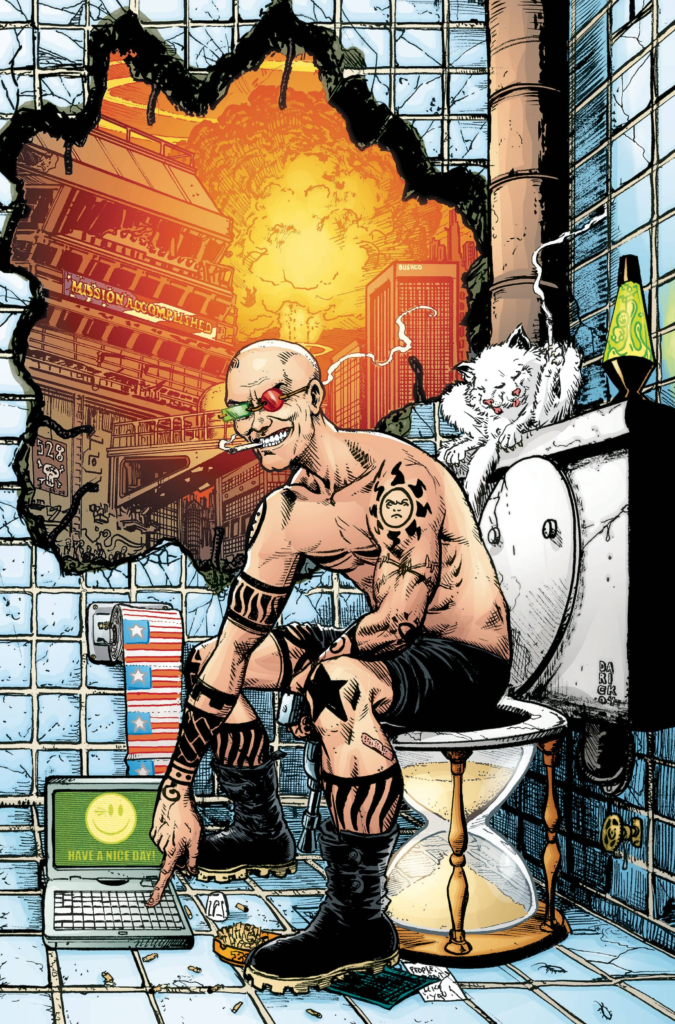
Exploring Key Themes
“Transmetropolitan” explores a multitude of thought-provoking themes that resonate with contemporary society, offering poignant reflections on power, technology, and the human condition. Through its incisive storytelling and vivid characters, Warren Ellis crafts a narrative that delves deep into the complexities of the modern world, inviting readers to confront the pressing issues of our time. Below are some of the key themes explored in “Transmetropolitan”:
1. Power and Corruption
Central to the narrative of “Transmetropolitan” is the theme of power and its corrupting influence. The City, with its sprawling metropolis and towering skyscrapers, serves as a microcosm of society, where those in positions of authority wield their influence with impunity, often at the expense of the marginalized and disenfranchised. Through characters like The Smiler and other corrupt politicians, Ellis exposes the dark underbelly of power, showcasing the lengths to which individuals will go to maintain their control over others.
2. Technology and Its Consequences
In the futuristic world of “Transmetropolitan,” technology reigns supreme, shaping every aspect of daily life. From ubiquitous surveillance to bioengineered enhancements, the City is a testament to humanity’s relentless pursuit of progress. However, this technological advancement comes at a cost, as evidenced by the rampant commodification of identity, erosion of privacy, and widening gap between the haves and have-nots. Through his exploration of technology, Ellis raises questions about the ethical implications of scientific innovation and the need for responsible stewardship of technological progress.
3. Truth and Journalism
At its core, “Transmetropolitan” is a story about journalism and the pursuit of truth in a world rife with misinformation and propaganda. Spider Jerusalem, with his unyielding commitment to journalistic integrity, serves as a beacon of light in the murky waters of media manipulation and corporate influence. Through his investigations and exposés, Ellis highlights the importance of a free and independent press in holding those in power accountable and safeguarding the principles of democracy.
4. Identity and Authenticity
The characters in “Transmetropolitan” grapple with questions of identity and authenticity in a society that prizes conformity and commodification. Spider Jerusalem, with his abrasive demeanor and uncompromising ethos, stands in stark contrast to the superficiality and shallowness of the City’s denizens, challenging them to confront their own values and beliefs. Through his interactions with characters like Channon Yarrow and Yelena Rossini, Ellis explores the complexities of personal identity and the struggle to remain true to oneself in a world that demands conformity.
5. Social Justice and Activism
Throughout “Transmetropolitan,” themes of social justice and activism permeate the narrative, as characters like Spider Jerusalem and Yelena Rossini fight against injustice and oppression. Whether it’s exposing government corruption, advocating for the rights of the marginalized, or amplifying the voices of the disenfranchised, Ellis portrays activism as a powerful force for change in a world desperately in need of reform. Through his portrayal of activism, Ellis inspires readers to take action and work towards building a more just and equitable society.
The Genesis of Inspiration
Warren Ellis’s “Transmetropolitan” draws inspiration from a diverse array of sources, ranging from classic works of science fiction to contemporary political commentary. Through his eclectic influences, Ellis creates a rich and immersive world that reflects the complexities of modern society while offering a visionary glimpse into the future. Below are some of the key inspirations behind “Transmetropolitan”:
1. Cyberpunk Literature
The cyberpunk genre, with its dystopian visions of the future and emphasis on technology, heavily influenced the world-building of “Transmetropolitan.” Works such as William Gibson’s “Neuromancer” and Neal Stephenson’s “Snow Crash” provided Ellis with a blueprint for creating the gritty and hyperrealistic setting of the City, complete with its towering skyscrapers, neon-lit streets, and pervasive surveillance.
2. Gonzo Journalism
At the heart of “Transmetropolitan” lies the spirit of gonzo journalism, a style of journalism characterized by its immersive and subjective approach to storytelling. Inspired by the work of Hunter S. Thompson, Ellis imbues Spider Jerusalem with the same larger-than-life persona and unapologetic voice, blurring the lines between fact and fiction as he navigates the chaotic landscape of the City.
3. Political Satire
Ellis’s keen eye for political satire shines through in “Transmetropolitan,” as he skewers the hypocrisies and absurdities of contemporary politics with razor-sharp wit and biting commentary. Drawing inspiration from satirical works such as George Orwell’s “1984” and Jonathan Swift’s “Gulliver’s Travels,” Ellis crafts a narrative that is both provocative and incisive, challenging readers to confront the darker aspects of human nature and societal power dynamics.
4. Cultural Observations
In addition to literary influences, Ellis drew inspiration from his own observations of modern society, incorporating elements of contemporary culture and technology into the fabric of “Transmetropolitan.” From social media addiction to corporate greed, the series serves as a reflection of the anxieties and obsessions of the digital age, offering a cautionary tale of the potential consequences of unchecked progress and technological advancement.
5. Personal Experiences
Like many creators, Ellis infused “Transmetropolitan” with elements of his own personal experiences and beliefs, adding a layer of authenticity and intimacy to the narrative. From his background in journalism to his own struggles with mental health, Ellis draws upon his own life to inform the character of Spider Jerusalem and the themes explored throughout the series, creating a work that is both deeply personal and universally resonant.
Biography of Warren Ellis
Warren Ellis, a trailblazing figure in the world of comic books and speculative fiction, has carved out a distinguished career marked by innovation, creativity, and uncompromising vision. Born on February 16, 1968, in Essex, England, Ellis exhibited a passion for storytelling from a young age, fueled by a voracious appetite for literature and a keen interest in science fiction and technology.
Early Life and Influences
Growing up in the UK during the 1970s and 1980s, Ellis was immersed in a cultural landscape shaped by the burgeoning punk rock movement, underground comics, and the explosion of science fiction in popular media. Influenced by authors such as William Gibson, Philip K. Dick, and Alan Moore, Ellis developed a distinctive voice and aesthetic that would come to define his work in the years to come.
Career Beginnings
Ellis’s career in comics began in the late 1980s and early 1990s, with his first published works appearing in British anthology titles such as “2000 AD” and “Warrior.” It was during this time that Ellis honed his craft as a writer, experimenting with different genres and styles while pushing the boundaries of conventional storytelling.
Rise to Prominence
Ellis’s breakthrough came in the mid-1990s with the publication of “Transmetropolitan,” a groundbreaking series co-created with artist Darick Robertson. Set in a dystopian future, “Transmetropolitan” garnered critical acclaim for its bold storytelling, dynamic artwork, and incisive social commentary, establishing Ellis as a visionary talent in the world of comics.
Prolific Output and Diverse Projects
Throughout his career, Ellis has demonstrated a remarkable versatility and prolificacy, producing a diverse range of work across multiple mediums. From the cosmic intrigue of “Planetary” to the geopolitical thriller “Global Frequency,” Ellis’s oeuvre spans genres and formats, showcasing his ability to tackle complex themes with intelligence, wit, and imagination.
Legacy and Influence
Warren Ellis’s impact on the world of comics and speculative fiction is immeasurable, with his work inspiring a new generation of creators and pushing the boundaries of the medium. His visionary storytelling, uncompromising vision, and unapologetic exploration of the human condition have earned him a dedicated following and cemented his status as one of the most influential voices in contemporary comics.
Personal Life and Philanthropy
Outside of his work in comics, Ellis is known for his outspoken advocacy on issues such as freedom of speech, digital privacy, and the role of technology in society. He is also an active supporter of charitable causes, donating proceeds from his work to organizations such as the Comic Book Legal Defense Fund and the Electronic Frontier Foundation.
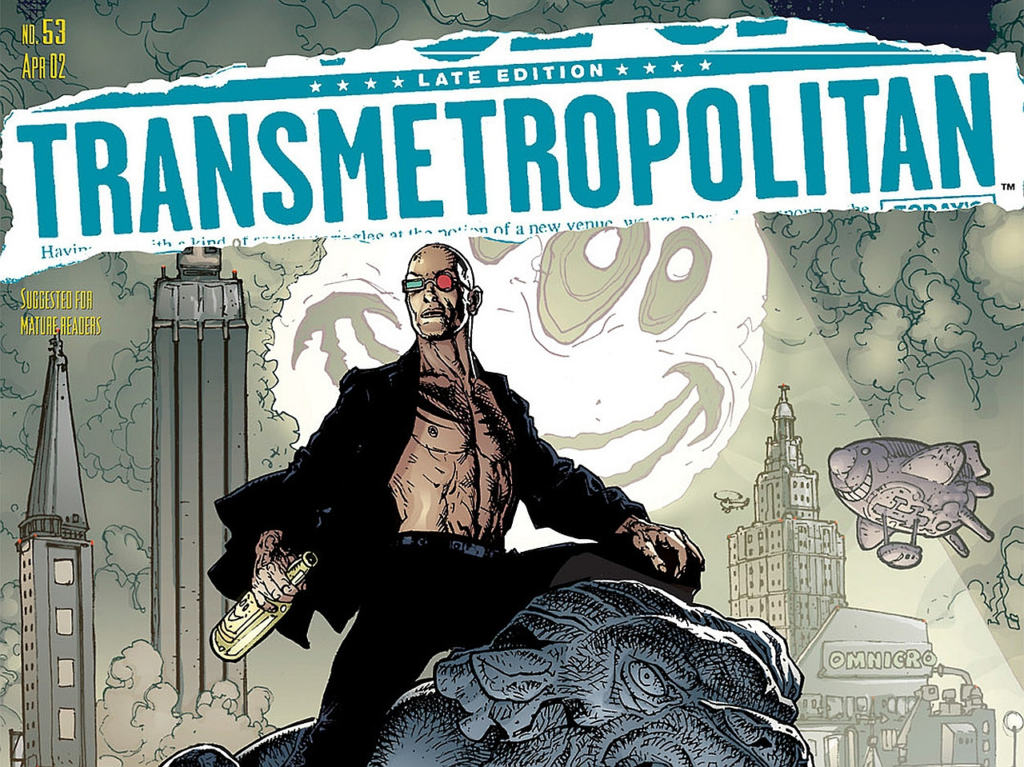
Critical Acclaim and Reviews
“Transmetropolitan” has garnered widespread acclaim from critics and readers alike, earning praise for its bold storytelling, dynamic artwork, and incisive social commentary. The series has been hailed as a seminal work in the realm of graphic fiction, revered for its uncompromising vision and unapologetic exploration of taboo subjects.
With its blend of dark humor, biting satire, and visionary world-building, “Transmetropolitan” stands as a testament to Ellis’s unparalleled talent and enduring influence.
Exploring Similar Works to Transmetropolitan
“Transmetropolitan” stands as a groundbreaking work in the realm of graphic fiction, pushing the boundaries of storytelling and exploring themes of power, technology, and the human condition in a dystopian future. Its unique blend of cyberpunk aesthetics, political satire, and gonzo journalism has inspired a new wave of creators to explore similar themes and narrative styles. Below are some works that share thematic elements and stylistic approaches with “Transmetropolitan,” offering readers a diverse array of stories to explore:
1. “The Invisibles” by Grant Morrison
Published by DC Vertigo, “The Invisibles” is a mind-bending journey through conspiracy, magic, and counter-cultural rebellion. Written by acclaimed author Grant Morrison, the series follows a group of anarchist operatives as they battle against oppressive forces that seek to control humanity’s destiny. Like “Transmetropolitan,” “The Invisibles” blends elements of science fiction, political commentary, and surrealism to create a narrative that challenges conventions and expands the possibilities of the medium.
2. “V for Vendetta” by Alan Moore and David Lloyd
“V for Vendetta,” written by comics legend Alan Moore and illustrated by David Lloyd, is a seminal work of dystopian fiction that explores themes of totalitarianism, resistance, and personal freedom. Set in a future Britain ruled by a fascist regime, the story follows a masked vigilante known only as V as he wages a one-man war against the oppressive government. With its incisive social commentary and morally complex characters, “V for Vendetta” shares thematic similarities with “Transmetropolitan,” offering readers a thought-provoking exploration of power and resistance in a society on the brink of collapse.
3. “Y: The Last Man” by Brian K. Vaughan and Pia Guerra
“Y: The Last Man” is a critically acclaimed comic book series created by writer Brian K. Vaughan and artist Pia Guerra. The series follows Yorick Brown, the last surviving man on Earth after a mysterious plague wipes out every other male mammal on the planet. As Yorick embarks on a journey to uncover the truth behind the catastrophe, he encounters a diverse array of characters and confronts questions of gender, identity, and the nature of humanity. Like “Transmetropolitan,” “Y: The Last Man” combines elements of speculative fiction, social commentary, and character-driven drama to create a compelling and thought-provoking narrative.
4. “Neuromancer” by William Gibson
Considered a seminal work in the cyberpunk genre, “Neuromancer” by William Gibson is a visionary exploration of technology, artificial intelligence, and the dark underbelly of cyberspace. Set in a future where multinational corporations hold sway over society, the story follows a washed-up computer hacker named Case as he is recruited for one last job that could change the course of history. With its gritty atmosphere, cutting-edge technology, and morally ambiguous characters, “Neuromancer” shares thematic and aesthetic similarities with “Transmetropolitan,” offering readers a glimpse into a world where the boundaries between man and machine blur.
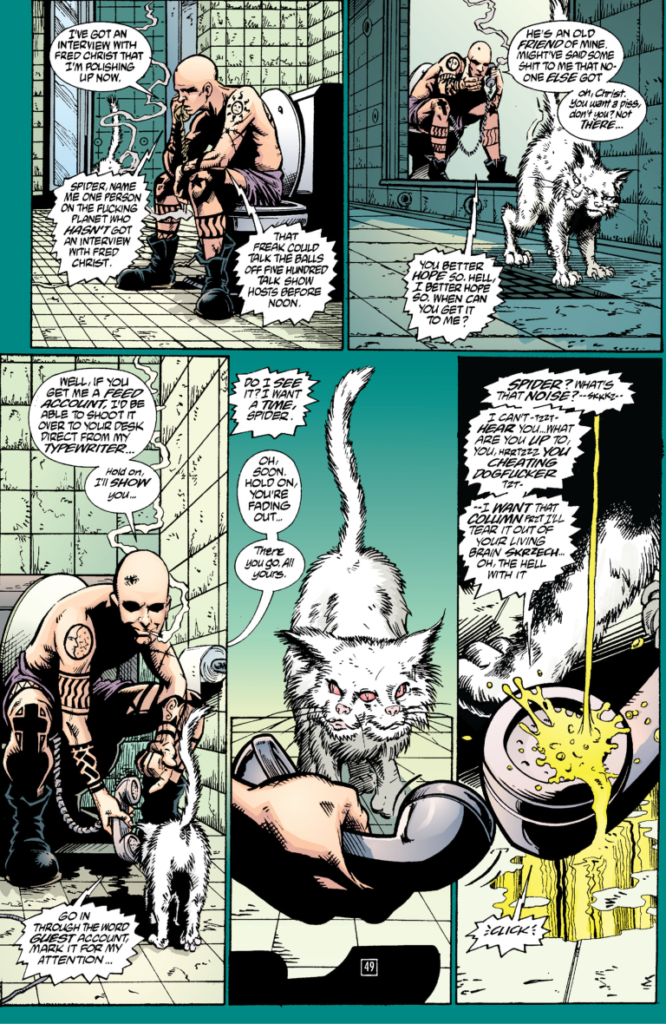
5. “Saga” by Brian K. Vaughan and Fiona Staples
“Saga” is an epic space opera created by writer Brian K. Vaughan and artist Fiona Staples. Set in a war-torn galaxy populated by fantastical creatures and interstellar conflicts, the series follows two star-crossed lovers from warring factions as they struggle to protect their newborn daughter from forces that seek to tear their family apart. With its sprawling scope, complex characters, and thought-provoking themes of love, family, and identity, “Saga” shares thematic and narrative similarities with “Transmetropolitan,” offering readers a captivating and emotionally resonant journey through the cosmos.
The Publication History of Transmetropolitan
“Transmetropolitan,” the seminal graphic novel series created by writer Warren Ellis and artist Darick Robertson, embarked on a journey that captivated readers with its bold storytelling and visionary world-building. Spanning over five years, the publication history of “Transmetropolitan” is a testament to its enduring impact and influence in the realm of comic books and speculative fiction.
Genesis of the Series
“Transmetropolitan” debuted in 1997, published by DC Comics’ imprint, Helix. The series was born out of Ellis’s desire to explore the intersection of cyberpunk aesthetics, political satire, and gonzo journalism. With artist Darick Robertson bringing his dynamic artwork to the table, the stage was set for a groundbreaking collaboration that would push the boundaries of the medium.
Helix Imprint and DC Vertigo
Initially serialized under the Helix imprint, “Transmetropolitan” faced challenges due to the imprint’s closure in 1998. However, the series found a new home at DC Vertigo, a prestigious imprint known for its groundbreaking and mature-themed titles. Under Vertigo, “Transmetropolitan” gained increased visibility and critical acclaim, solidifying its reputation as a must-read series for fans of alternative and edgy comics.
Serialized Run and Collected Editions
From 1997 to 2002, “Transmetropolitan” was serialized in 60 issues, each filled with Ellis’s trademark wit, social commentary, and larger-than-life characters. The series was collected into ten trade paperback volumes, making it accessible to readers who preferred to consume the story in collected form. These collected editions allowed new audiences to discover the world of the City and its irreverent protagonist, Spider Jerusalem, in its entirety.
Legacy and Continued Influence
Since its conclusion, “Transmetropolitan” has remained a beloved and influential work in the realm of graphic fiction. Its impact can be seen in the resurgence of interest in cyberpunk aesthetics, as well as the ongoing relevance of its themes of media manipulation, political corruption, and the dangers of unchecked technological advancement. The series continues to inspire creators and readers alike, serving as a touchstone for those who seek to challenge conventions and explore the complexities of the modern world.
Transmetropolitan Book One
Combining black humor, life-threatening situations and moral ambiguity, Warren Ellis’ legendary series is the first look into the mind of an outlaw journalist and the world he seeks to destroy. This new trade paperback recut series features behind-the-scenes material, variant covers and scripts from the graphic novel series run. Collects issues #1-12.
Transmetropolitan
In “Transmetropolitan,” Warren Ellis transcends the confines of traditional storytelling, crafting a visceral and unflinching portrait of a world in turmoil. Through its vivid characters, incisive themes, and audacious narrative, “Transmetropolitan” invites readers to confront the complexities of the human condition and the pressing issues of our time. As a testament to Ellis’s enduring legacy, “Transmetropolitan” remains a landmark achievement in the realm of graphic fiction, continuing to captivate and provoke audiences with its bold vision and uncompromising spirit.

